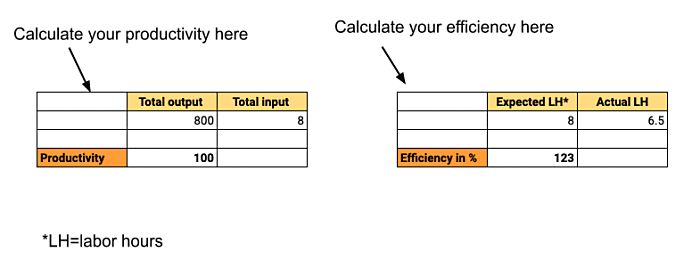Productivity vs efficiency: what is the difference and why it matters
Last updated on: September 13, 2022
You’ve probably used the words “productivity” and “efficiency” interchangeably so many times. But did you ever stop to think if these two terms are really one and the same? The answer is — No. Productivity refers to the quantity of work while efficiency refers to the quality.
However, one cannot go without the other since they are interdependent and go hand in hand.
In this blog post, we will talk about the differences between productivity and efficiency, their correlation, and some useful tips to increase them.

Table of Contents
What is productivity?
Productivity is performance — tendency towards making the most out of available resources. Due to the competitive market today, entrepreneurs are more inclined towards results and numbers. However, productivity is not solely the number of products produced or services provided within a specific period.
Productivity is indeed the output (i.e. produced goods or services), but one that is the result of the input (i.e. used resources). Or as the National Bureau of Economic Research proposes, productivity refers to the “units of output produced per unit of a particular input.”
If we produce more or better output using the same resources, productivity will increase. Equally, if we use fewer resources to produce the same output, we also increase productivity.
So, productivity means much more than just numbers. It’s the measurement of the performance that is gained using specific input. When you focus on productivity, you focus on achieving more using the same (or fewer) resources.
Example of productivity at the workplace
Let’s say you are an HR manager, and your average time to interview a potential employee is thirty minutes. If your company solely focuses on productivity, they will probably instruct you to interview two candidates within the same timeframe (thirty minutes).
Therefore, you are trying to find a way to accelerate the process, omit some standard questions, and decrease your candidate’s speaking time.
Finally, you succeed in interviewing two candidates within the same timeframe. However, you are afraid you didn’t make the right decision due to a lack of time when getting to know your candidates. Moreover, you experience burnout because of the pressure to do more using the same amount of resources (which is time, in this case).
In short, solely focusing on productivity and getting more things done while using the same resources may not result in better quality.
What is efficiency?
Sink and Tuttle (1989) describe efficiency as “doing things right.” Simply put, efficiency is the degree to how well resources are utilized to achieve the output. When you focus on efficiency, you focus on achieving the same using fewer resources.
Companies that improve labor efficiency are reducing hours, workforce, or budget to produce the same output. This is done to save and increase profitability.
If productivity focuses on results, efficiency is all about the resources invested to achieve those results.
Example of efficiency at the workplace
You are a content writer and you write for a blog. You need to finish your blog post in five working days. On average, you can write 700 to 800 words a day (together with research, brainstorming, etc.).
Now, your manager tells you that you will need to finish your future blog posts within three working days. There has been some labor shortage in the company lately, and a decreased number of employees will have to achieve the same output. Therefore, you need to do the same work now but using fewer resources i.e. time.
You somehow manage to finish your blog post on time, but you worry that you didn’t do enough research and answer the topic well.
Consequently, doing the same work while using fewer resources may not result in better quality either.
Correlation between productivity and efficiency
So, productivity means doing more work during the same time frame, while efficiency means doing the same amount of work in less time. Even though productivity and efficiency are two separate things, we must know that they are interdependent. If productivity refers to the quantity of the output produced, efficiency would be the quality of that output. So, if there is resource scarcity, the process to do the work is less efficient and reflects poorly on the output — productivity. Productivity is ultimately contingent on the resources, i.e. efficient usage of them.
In essence, when the quality, i.e. efficiency is added to get the output, i.e. productivity, we get true productivity.
Example of productivity vs efficiency in manufacturing
In the 1970s, the top manufacturing output countries were the USA, USSR, and Japan, ranking China fifth. However, in 2010, China overtook the USA and ranked first place in the highest manufacturing output in the world (which it still holds today).
According to 2015 research, China leads the world with $2.01 trillion in manufacturing output, placing the USA second with $1.867 trillion and Japan with $1.063 trillion in manufacturing output. Moreover, China accounts for 20% of manufacturing output worldwide.
How did the Chinese accomplish that?
China owes its flattering title to low input costs. In 2018, manufacturing wages in China were $5.51 per hour while in the USA, the wages were $26.99 per hour. Low costs of production, including workforce, materials, and numerous government subsidies, all contribute to high production outputs.
But, one must wonder, if productivity is the result of the input — in China’s case, low-paid workforce and raw materials — is it a quality result?
When you take hourly wages in China and the USA into consideration, there is a significant deviation indeed. That’s why you will find the price of, for instance, unbranded headphones in China (or on their numerous shopping websites) to be twice or three times lower than in the USA. The quality, therefore, is poorer as well. Thus, you get what you paid for.
From this example, we can conclude that a high productivity rate doesn’t necessarily result in quality goods or services. China is well-known for its cheap products, and they will always have buyers indeed. However, one can achieve the best ratio when successfully balancing both productivity and efficiency. But, first, you’ll need to calculate productivity and efficiency in your business.
How do you calculate productivity and efficiency?
Calculating productivity helps your business to adapt and adjust in order to achieve better results. By doing so, you can point at shortages or actions to be taken to improve productivity. Moreover, you can have a clear insight into predicaments that might have interfered with productivity.
When you calculate productivity, you control:
- Resource estimations and allocations,
- Goal setting,
- Improvement,
- Budgeting.
Also, when you calculate your or your business’ efficiency, you can see how resources are utilized and avoid wasting.
Productivity formula
Use this simple equation to calculate your or your employee’s productivity. You can do it for each team member individually or the entire team.
TOTAL OUTPUT / TOTAL INPUT = PRODUCTIVITY
Let’s take a look at the example with the content writer. So, the content writer writes 800 words and in order to do so, it takes her 8 working hours. The output would be 800 words, and 8 working hours would be the input, the resources (time in this case) that are invested to achieve results. If we want to calculate the content writer’s productivity, we must divide 800 words (output) by 8 working hours (input).
The equation goes as follows:
800 / 8 = 100
So, the content writer writes 100 words per hour. By taking this result into consideration, she may have a closer look into her productivity and the things she can do to improve it, perhaps.
If you, for instance, want to calculate your business’s productivity on a larger level, you can do so by following the same equation. Say your business manufactures $80,000 (output) worth of goods or services per 1 week. In order to produce the goods and provide the services, it takes your business 1,300 labor hours (input).
Take a look at the equation again:
80,000 / 1,300 = 61
The number we’ve got is 61, and that result represents how much dollars is earned for each labor hour. The result: $61 per 1 labor hour.
By measuring your or your business’s productivity, you can have a closer look at the utilization of your resources, and it will help you be more productive with them.
Efficiency formula
Calculating productivity will help you get a closer insight into quantity while calculating efficiency will help you evaluate the quality. We don’t know what is the quality of the goods manufactured or services provided when we calculate productivity. We just get the numbers. Maybe 100 words from the previous example is productive work, but we don’t know if it is high-quality content.
Use the following equation to calculate your or your business’s efficiency.
( Expected labor hours of work / actual labor hours worked ) x 100% = EFFICIENCY
Maybe the content writer is expected to work 8 hours a day. But, let’s say she actually finishes her work in 6.5 hours a day. If we divide 8 (her expected labor hours) by 6.5 (actual hours worked) and multiply that by 100, we will get the efficiency of the content writer’s work.
Take a look at the equation:
( 8 / 6.5 ) x 100 = 123% efficiency
A ratio higher than 100% indicates greater efficiency. That is to say, the content writer works 1.5 hours less than expected, so she is 23% more efficient.
Let’s say you want to calculate your business’s efficiency on a weekly level. If we take a look at the previous example, it takes 1,300 labor hours weekly to produce $80,000 of output.
In this case, we are not interested in productivity, so we leave $80.000 aside. Instead, we take 1,000 (expected labor hours) and divide it by 1,300 (actual hours worked), and multiply that by 100 to get the efficiency of the workers.
( 1,000 / 1,300 ) x 100 = 76% efficiency
This result indicates that workers need more hours to deliver results, hence, their efficiency is lower than expected. This is a simple equation that can help a business have a closer look into their employees’ efficiency and react if needed.
A free productivity and efficiency calculator
We’ve prepared a free productivity and efficiency calculator for you so that you never experience a stall in productivity or inefficient use of resources again. In Screenshot 1: Productivity and efficiency calculator, you can see how it looks and how it is easy to use.

Screenshot 1: Productivity and efficiency calculator
🔽Download the Free productivity & efficiency calculator
How to increase productivity and efficiency at work?
Whether you are a company that wants to increase the productivity of your employees or an individual trying to boost your performance, doing so will provide you with various benefits. Increasing productivity for companies will result in better profit and economic growth. On an individual level, boosting productivity can help you obtain higher wages or additional benefits and perks at work. Employees who are satisfied with their working conditions tend to be more productive at work hence provide better results. Moreover, satisfied and engaged employees are more likely to be efficient and show a prudent use of resources.
Try incorporating the tips we’ve prepared for you into your daily routine to increase your or your employees’ productivity and efficiency.
Tips for businesses
No matter how well your business is going, you must always keep an eye on productivity and efficient use of your business’s resources. You can’t allow unforeseen costs and poor utilization of resources since competition is out there, waiting for you to slip. If you would like to boost your profits while making the most of your resources, read the following tips.
Solicit employee feedback
Conducting feedback from your employees can help you better understand their needs, opinions, and viewpoints hence boost your company’s productivity. Create surveys and organize team meetings regularly. Meetings can indirectly reflect a company’s culture. If everyone is quiet during the meeting or even too agreeable, something must be wrong. When a company provides a welcoming and safe environment, employees are not afraid to share ideas and are more likely to achieve productive results.
This way, you will achieve a better understanding of your employees’ productivity, how they utilize resources at their disposal, and what’s stopping them to achieve their goals. Consider having a check-in with your employees once a week at least.
Encourage learning opportunities
According to research, additional training and knowledge enhancement on current jobs have a beneficial impact on employees’ productivity. The key is to keep enhancing and improving your employees’ skills and knowledge. Provide them with learning opportunities including different seminars, language classes, and workshops. What’s more, introduce a mentoring program in your workplace. Novice employees will benefit from having a mentor since they will feel more encouraged and less frightened to do the work. In addition, as an employer, you can offer tuition assistance to motivate employees to improve their knowledge and encourage their professional development.
Have a clear company vision
When a company has a clear vision, it can create long-term and consistent results. Apart from creating results, it unifies everyone into a team and promotes teamwork. Moreover, it boosts employees’ morale and motivation. Therefore, a clear vision aids in creating a productive environment at work.
Have your employees track time
Tracking your employees’ time can be beneficial to both you and your employees’ performance. You can have a better insight into your employees’ daily activities and improve workload distribution among teams. They can achieve skills to use their time more efficiently and avoid poor resource utilization. Avoid outdated time trackers such as a punch clock, and opt for a tool that is rich in features and easy to use.
Thus, you can try out Clockify — a time tracking tool that offers the basic time tracking features for unlimited users and projects, and all that free of charge.
Timekeeping in Clockify can maximize productivity within your team and help you efficiently utilize resources (time, team members, and budget) without wasting them.
Efficiently allocate resources
It is a huge responsibility and concern to allocate resources efficiently. We’ve already said that true productivity depends on efficiency, i.e. quality utilization of resources. When you efficiently allocate time, people, money, and equipment, you avoid missed deadlines, unnecessary expenses, and a dysfunctional workplace. Remember that productivity refers to the output that people achieve with the efficient utilization of money, time, and accompanying equipment.
💡Check this article out and learn more about the importance of tracking resource allocation: How to track resource allocation
Tips for individuals
There are times when we all experience a stall in productivity and when we grasp at straws to use our resources efficiently. What you can do is take a look at the things that interfere with your productivity and introduce changes to your daily routines. Increase your productivity and use your resources efficiently with the tips that we’ve prepared for you.
Stop multitasking
Research shows that juggling multiple tasks at the same time prolongs the completion of tasks and has a detrimental effect on productivity. It also states that the more tasks you take on, the less productive you become. Therefore, instead of doing several things simultaneously, prioritize your workload and resolve important (not urgent) tasks first. This way, you will utilize your resources efficiently and never experience a stall in productivity again.
Organize your life better
If the current organizational methods you are using are doing more harm than good, consider changing them and adopting new ones into your daily routine. Try with simple workplace decluttering or introducing to-do lists to help you track your tasks more efficiently.
Have you ever heard of a time management method called time blocking?
By using this method, you divide your workday into blocks of time. You dedicate each time block to a specific task and set a timeframe for each. For example, research time from 9 a.m. to 11 a.m., writing time from 11 a.m. to 1 p.m., lunchtime from 1 p.m. to 2 p.m., etc. Follow your time blocks accordingly to be more efficient with your time. Make the most of your workday by implementing minor organizational changes in the workplace.
💡If you want to develop better organizational skills, you may find this article useful: How to better organize your life
Track your productivity
As an individual, you can also track your time in order to be more efficient with it and deliver consistent output. By tracking your time, you can see where your time goes and boost your productivity. If you are prone to procrastination, try out the Pomodoro technique that offers working in 25-minute intervals, followed by 5-minute breaks. It helps you focus on the task at hand, and millions around the world use it to improve productivity. Therefore, track your time to boost your productivity and improve your time management skills.
Eliminate distractions
Do you have a constant urge to check your social media? According to one 2017 study, social media is one of the main culprits for productivity deterioration. Cut off distractions by installing software for blocking irrelevant applications and websites during work hours. Additionally, turn off notifications and don’t be afraid to say “No” to your coworkers. Staying focused will help boost your productivity and use your resources more efficiently.
Use technology
Make technology an internal part of your workdays. It can save your time and speed up processes significantly. When you use technology, you efficiently allocate your resources. There is no need for you to waste your resources by doing things manually. Technology will efficiently allocate your resources and minimize the risk of mistakes. Keep in mind to use reliable tools only.
Conclusion
Balancing efficiency and productivity is walking a tightrope, but it is crucial in delivering consistent results. Whether you are an individual or an organization, taking both factors into consideration plays a pivotal role in achieving success. Remember that everyone faces obstacles from time to time. Try incorporating the tips we’ve prepared for you into your daily routines to overcome obstacles as efficiently as possible.
✉️ Do you ever face a stall in productivity or inefficient use of resources? How do you overcome them? Write to us at blogfeedback@clockify.me for a chance to be featured in this or future articles.





